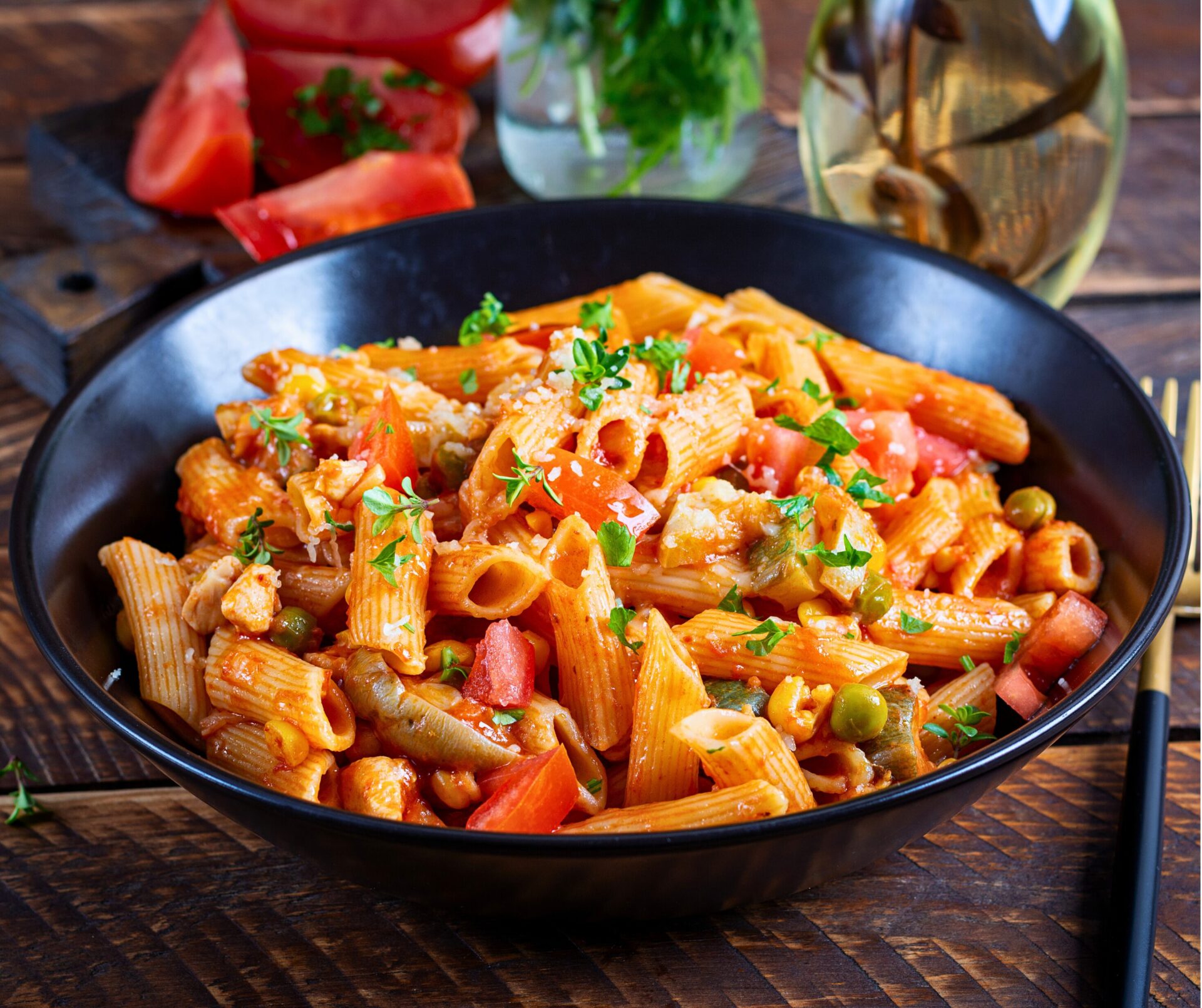Arrabbiata Sauce is a classic Italian sauce known for its bold, spicy kick and rich tomato flavor. Made with just a handful of simple ingredients like garlic, red pepper flakes, and tomatoes, this fiery sauce packs a punch and adds a burst of flavor to any dish. Perfect for those who love a little heat in their meals, Arrabbiata Sauce is versatile enough to be paired with pasta, used as a pizza base, or spooned over proteins and vegetables. Its quick preparation and robust taste make it a favorite in Italian kitchens and beyond, offering a delicious and satisfying way to spice up your culinary creations.
Full Recipe:
Ingredients
- 2 tablespoons olive oil
- 4 cloves garlic, minced
- 1 teaspoon red pepper flakes (adjust to taste)
- 1 (28 ounce) can crushed tomatoes
- 1 teaspoon salt
- 1/4 teaspoon freshly ground black pepper
- 1 teaspoon sugar (optional, to balance acidity)
- Fresh basil or parsley, chopped (optional, for garnish)
Instructions
- Sauté the Garlic and Red Pepper: In a large skillet or saucepan, heat the olive oil over medium heat. Add the minced garlic and red pepper flakes, sautéing until the garlic is fragrant but not browned, about 1-2 minutes. Be careful not to burn the garlic, as it can become bitter.
- Add the Tomatoes: Pour in the crushed tomatoes, stirring to combine. Add salt and black pepper, and stir well. If the tomatoes are very acidic, add the sugar to balance the flavors.
- Simmer the Sauce: Reduce the heat to low and let the sauce simmer for 15-20 minutes, stirring occasionally, until it thickens slightly and the flavors meld together.
- Adjust Seasoning: Taste the sauce and adjust the seasoning with more salt, pepper, or red pepper flakes if desired.
- Serve: Serve the Arrabbiata sauce over your favorite pasta, such as penne, spaghetti, or rigatoni. Garnish with fresh basil or parsley if desired. This sauce also pairs well with chicken, seafood, or vegetables.
More Information
Nutritional Information
Arrabbiata sauce is a simple yet flavorful sauce that’s low in calories and packed with nutrients. The crushed tomatoes are rich in vitamins A and C, potassium, and lycopene, an antioxidant known for its potential health benefits, including heart health and cancer prevention. Olive oil adds a dose of healthy monounsaturated fats, which support heart health and aid in the absorption of fat-soluble vitamins. Garlic not only enhances the flavor but also offers anti-inflammatory and immune-boosting properties. This sauce is naturally vegan and gluten-free, making it a versatile option for various dietary preferences.
Variations and Substitutions
- Heat Level: The spiciness of Arrabbiata sauce can be adjusted according to your preference. For a milder sauce, reduce the amount of red pepper flakes. For extra heat, add more red pepper flakes or a pinch of cayenne pepper.
- Tomato Options: While crushed tomatoes are traditional, you can use canned whole tomatoes and crush them by hand for a chunkier texture. Alternatively, fresh tomatoes can be used when in season for a fresher flavor.
- Herbs and Spices: Though the classic recipe focuses on garlic and red pepper flakes, you can add additional herbs like basil, oregano, or parsley for more depth. A splash of red wine or balsamic vinegar can also be added for a slightly different flavor profile.
- Richness: For a richer sauce, stir in a tablespoon of butter or a splash of heavy cream at the end of cooking. This will mellow the heat slightly and add a silky texture to the sauce.
Serving Suggestions
- Pasta: Arrabbiata sauce is most commonly served with pasta. It pairs exceptionally well with penne, allowing the sauce to cling to the pasta’s ridges. Top with freshly grated Parmesan cheese and a sprinkle of chopped parsley or basil for a classic Italian meal.
- Pizza: Use Arrabbiata sauce as a spicy base for homemade pizza. Spread it over the dough and add your favorite toppings, such as mozzarella, olives, and spicy sausage.
- Protein Pairing: This sauce complements proteins like chicken, shrimp, or tofu. Spoon it over grilled or baked chicken breasts or mix it with sautéed shrimp for a quick and flavorful meal.
- Vegetable Dishes: Drizzle Arrabbiata sauce over roasted vegetables, such as eggplant, zucchini, or bell peppers, to add a burst of spicy flavor. It also works as a dipping sauce for breadsticks or a topping for baked potatoes.
Storage and Shelf Life
- Refrigeration: Store leftover Arrabbiata sauce in an airtight container in the refrigerator for up to 4-5 days. Reheat it gently on the stovetop or in the microwave before serving.
- Freezing: This sauce freezes well. Allow it to cool completely, then transfer it to freezer-safe containers or zip-top bags. Freeze for up to 3 months. Thaw in the refrigerator overnight and reheat on the stovetop.
History and Origin
Arrabbiata sauce, known as “sugo all’arrabbiata” in Italian, originates from the Lazio region of Italy, particularly from Rome. The name “arrabbiata” means “angry” in Italian, a nod to the sauce’s fiery, spicy character. It is a classic example of cucina povera, or “poor kitchen,” a style of Italian cooking that emphasizes simple, inexpensive ingredients to create delicious and hearty dishes.
This sauce was traditionally made with just a handful of pantry staples: garlic, red pepper flakes, olive oil, and tomatoes. Its simplicity allowed it to be prepared quickly, making it a popular choice for everyday meals. Despite its straightforward ingredients, Arrabbiata sauce is known for its bold and intense flavor, capturing the essence of Italian cuisine’s love for vibrant, robust dishes.
Arrabbiata sauce gained international popularity as Italian cuisine spread across the world. Its characteristic heat and rich tomato flavor have made it a favorite among those who enjoy spicy dishes. Today, it is widely featured on Italian restaurant menus and in homes around the globe, often served with pasta like penne, which is traditionally used in this dish to catch the sauce in its tubular shape.
Nutritional Benefits
- Tomatoes: Tomatoes are the primary ingredient in Arrabbiata sauce, providing a wealth of nutrients. They are rich in vitamins A, C, and K, as well as potassium and folate. The high levels of antioxidants, particularly lycopene, in tomatoes are known for their heart-protective and anti-cancer properties. Cooking tomatoes, as in this sauce, actually increases the availability of lycopene, making it easier for the body to absorb.
- Garlic: Garlic is known for its numerous health benefits. It contains compounds like allicin, which have anti-inflammatory, antibacterial, and antiviral properties. Consuming garlic can help boost the immune system, reduce blood pressure, and support heart health.
- Olive Oil: Olive oil is a staple in Mediterranean cooking and is valued for its healthy fats, particularly monounsaturated fats. These fats support heart health by helping to reduce bad cholesterol levels. Olive oil is also rich in antioxidants and anti-inflammatory compounds, contributing to overall wellness.
- Low in Calories: Arrabbiata sauce is relatively low in calories, especially when compared to cream-based sauces. It is a great option for those looking for a flavorful yet light addition to their meals. Its combination of tomatoes, garlic, and olive oil provides a nutrient-dense choice without adding excess calories or unhealthy fats.
Flavor Profile and Enhancements
- Bold and Spicy: The defining characteristic of Arrabbiata sauce is its bold, spicy flavor. The heat comes from red pepper flakes, which can be adjusted to suit your spice tolerance. The garlic adds a pungent, aromatic element, while the tomatoes provide a tangy and slightly sweet base.
- Rich and Savory: The olive oil adds a richness that helps to balance the acidity of the tomatoes and the spiciness of the red pepper flakes. The slow simmering process allows the flavors to meld together, resulting in a rich and savory sauce that is both simple and robust.
- Customizable: While Arrabbiata sauce is traditionally made with just a few ingredients, it can be customized to enhance its flavor. Adding fresh herbs like basil or oregano can introduce an aromatic freshness. A splash of red wine or balsamic vinegar can deepen the flavor profile, adding a layer of complexity. For those who prefer a smoky taste, consider adding a pinch of smoked paprika or chipotle powder.
Preparation Tips
- Controlling the Heat: The level of spiciness in Arrabbiata sauce can be easily adjusted by varying the amount of red pepper flakes. Start with a small amount if you’re sensitive to heat, and increase it gradually to find your desired spice level. Remember that the longer the sauce simmers with the red pepper flakes, the more intense the heat will become.
- Quality Ingredients: Since Arrabbiata sauce relies on a few simple ingredients, using high-quality products makes a big difference. Opt for good-quality canned tomatoes, preferably San Marzano if available, as they have a sweeter and less acidic flavor. Use extra virgin olive oil for the best taste and health benefits.
- Blending the Sauce: If you prefer a smoother texture, you can blend the sauce using an immersion blender directly in the pan or transfer it to a blender. Blending the sauce can help distribute the flavors more evenly and create a more velvety consistency.
Serving Suggestions
- Classic Pasta Dish: Arrabbiata sauce is traditionally served with pasta, especially penne. The tube-shaped pasta holds the sauce well, allowing you to enjoy the full intensity of the spicy tomato sauce in every bite. Sprinkle with freshly grated Parmesan cheese and garnish with fresh basil for a classic Italian meal.
- Pizza Sauce: Use Arrabbiata sauce as a spicy base for pizza. Spread it over pizza dough and top with mozzarella, spicy sausage, or roasted vegetables. The sauce’s fiery flavor pairs well with a variety of toppings, adding a kick to your homemade pizza.
- Protein Pairing: This sauce is versatile enough to accompany proteins like chicken, shrimp, or tofu. Spoon it over grilled chicken breasts or baked tofu for a spicy, flavorful main dish. It can also be used as a sauce for meatballs or as a base for spicy shakshuka.
- Dipping Sauce: Serve Arrabbiata sauce as a dipping sauce for garlic bread, breadsticks, or fried appetizers. Its bold flavor makes it an excellent accompaniment for a variety of snacks and finger foods.
Storage and Freezing Tips
- Make-Ahead: Arrabbiata sauce is perfect for making ahead. The flavors often deepen and develop after a day in the refrigerator, making it even more delicious when reheated.
- Freezing: This sauce freezes well, so consider making a double batch and storing it in the freezer for quick and easy meals. Let the sauce cool completely before transferring it to freezer-safe containers or zip-top bags. Label with the date and freeze for up to 3 months. Thaw in the refrigerator overnight and reheat gently on the stovetop.
Why This Recipe Stands Out
- Quick and Simple: Despite its complex flavor, Arrabbiata sauce is quick and simple to prepare. It requires only a handful of ingredients and minimal cooking time, making it an ideal choice for weeknight dinners or last-minute meals.
- Bold and Satisfying: The bold, spicy kick of Arrabbiata sauce makes it a satisfying option for those who enjoy a bit of heat in their food. Its rich tomato base, combined with the warmth of garlic and chili, creates a sauce that’s both hearty and invigorating.
- Versatile and Customizable: This sauce can be easily adapted to suit different tastes and dietary preferences. It can be made milder or spicier, thicker or thinner, depending on your preference. It pairs well with a wide range of dishes, from pasta and pizza to proteins and vegetables.
Cultural Significance and Modern Adaptations
- Roman Roots: Arrabbiata sauce hails from the Lazio region of Italy, particularly from Rome. It is a traditional Italian sauce that reflects the Roman love for bold, spicy flavors. The simplicity of the recipe, using basic pantry ingredients, highlights the Italian culinary philosophy of letting a few high-quality ingredients shine.
- Global Popularity: With the global popularity of Italian cuisine, Arrabbiata sauce has become a beloved spicy alternative to classic marinara. It has inspired numerous variations and adaptations, often featuring additional ingredients like capers, olives, or anchovies for added depth and complexity. Despite these modern twists, the essence of Arrabbiata sauce remains the same—a spicy, robust, and deeply flavorful tomato sauce.
- Fusion Dishes: In modern cuisine, Arrabbiata sauce is used in various fusion dishes. It serves as a base for spicy stews, casseroles, and even breakfast dishes like shakshuka. Its versatility and bold flavor have made it a staple in both traditional Italian cooking and contemporary culinary creations.
Conclusion
Arrabbiata Sauce is a fiery and flavorful classic that embodies the essence of Italian cooking. With its simple ingredients and bold, spicy taste, it’s a versatile sauce that adds a kick to pasta, proteins, and vegetables alike. Perfect for those who love a bit of heat in their meals, this sauce is easy to prepare yet delivers a depth of flavor that makes it feel special. Whether you’re serving it over a bowl of pasta, using it as a pizza base, or adding it to a favorite dish, Arrabbiata Sauce brings a touch of Italy to your kitchen. Its rich history and timeless appeal make it a beloved choice for spice lovers and Italian food enthusiasts everywhere.






